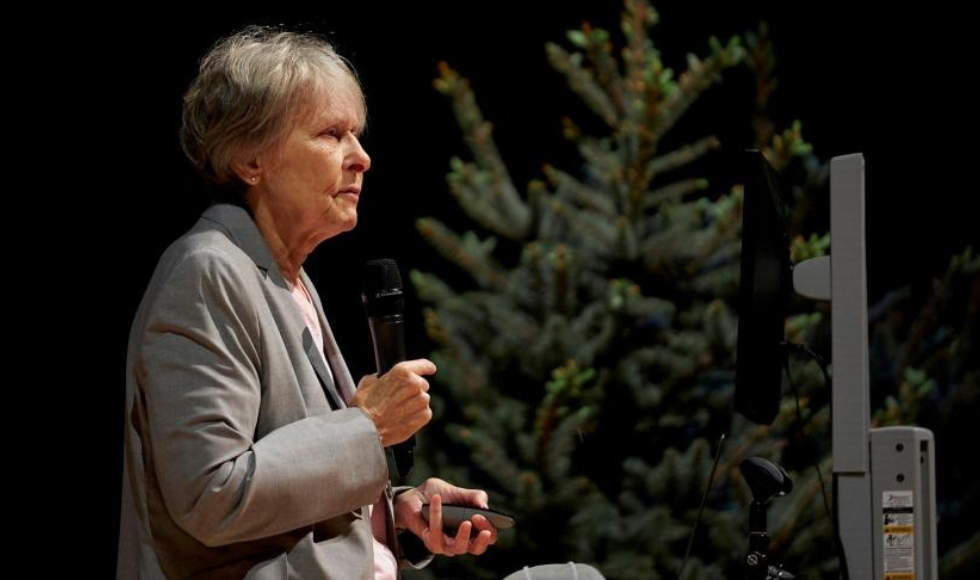‘We’ve got to inspire others’: astronaut Roberta Bondar visits McMaster

Astronaut and McMaster University alumna Roberta Bondar delivers her lecture presentation, “Perspective Shift: Moving Beyond the Familiar to Reach the Extraordinary” at L.R. Wilson Hall on June 1. (Image by Mike Lalich)
McMaster University alumna Roberta Bondar, the first Canadian woman and neurologist in space, discusses how to anchor our journeys and the power of art and science to save the earth.
As the rain poured down on the roof of L.R. Wilson Hall, and the sound of droplets amplified across the auditorium, astronaut Roberta Bondar looked out to the crowd.
“Isn’t that an amazing thing,” she said. “Gravity.”
Roberta Bondar, ‘77, was on campus at McMaster University for her lecture presentation, “Perspective Shift: Moving Beyond the Familiar to Reach the Extraordinary.”
Hosted by the W Booth School of Engineering Practice and Technology, in partnership with the Faculty of Engineering and Office of the VP Research, the event allowed the opportunity for hundreds of attendees to learn from the remarkable scientist.

This year marks the 30-year anniversary of Bondar’s journey aboard the space shuttle Discovery, when she became the first Canadian woman and neurologist in space. Two trees will be planted on campus in her honour and recognition of this accomplishment.
Here are some key takeaways from Bondar’s presentation.
Finding your footholds
In 1992, Bondar and the Mission STS-42 crew launched into space to study how microgravity affected, among other aspects, the human body. But her learnings on the spacecraft, Bondar explained, went beyond the scientific.
For eight days, Bondar juggled a schedule teeming with experiments and a lengthy checklist with her desire to stare out the window at the astonishing view of the earth.
Her experience drove home the fact that our feet always want to find the ground.
“We always have to think about having something that grounds us – even if we’re floating in outer space,” Bondar said.

When Bondar thinks of footholds to her own journey in life, she finds them among books and 70 mm film.
As a young girl, Bondar was dazzled by a book of stars with 150 paintings in colour. Later on in life, she was struck by Rachel Carson’s Silent Spring, an environmental awakening to the harms of DDT on wildlife and humans.
She recalled the unprecedented colour photograph by astronaut Bill Anders in 1968, Earthrise, which captured the dark side of the moon in the foreground and the earth rising beyond.
This combination of footholds guided her path: a road, she said, that “makes you who you are.”

She urged those in attendance, including a Grade 6 class from nearby Canadian Martyrs Catholic Elementary School, to think back on their respective footholds for inspiration.
Keep items, she said, that exude the energy of curiosity and youth to reconnect with that inner self when doubt needles its way through.
Life isn’t linear, she said, “it’s a pinball machine.” She challenged the audience to follow their interests in the face of the unexpected.
Passion, she said, is the key to our strength – and sometimes we see what others cannot.
“Without passion, you’ll never enjoy the journey,” she said.

Engage, Engage, Engage
As Bondar gazed at the edges of the earth, a planet of rich blues and greens that popped against the blackness of space, she reflected that she had a unique opportunity.
Astronauts do not always get to explore what they see in space: the crew that delivered the photo Earthrise circled the moon 10 times, but did not land.
“What an exciting thing for me to come back and explore the surface of [the earth],” she said.

When Bondar returned to earth, she dove into her passion of improving education of the environment with her photography.
She shared striking shots with the audience, ranging from oblique lines of Dinosaur Provincial Park to a towering Mount Logan with a half moon taken from a helicopter on the eve of the 30th anniversary of Apollo 11 moon landing, and with the same type of camera too.

Cameras, Bondar said, are a documentary resource of life, but also a way to show what you’re thinking.
The Roberta Bondar Foundation runs the “Bondar Challenge,” which calls on people to engage with and take photos of the environment to learn about the beauty of earth and conservation.
“If you love something, you’ll want to protect it,” she said.

The power of photography thundered in her own shots of wildlife.
The audience gasped as Bondar showed endangered whooping cranes in Wood Buffalo National Park, while she spoke in awe of the 4,000-kilometre migration they make to Texas in the fall.
Bondar pointed out the beauty and fragility conveyed in photos of lesser flamingos, taken at the hotbed of Lake Natron in Tanzania. These birds of bright pink plumage rely on their environment, and showing compelling photos of the creatures in their habitat helps punctuate the need for conservation.
Science is about fact, Bondar said, but “the facts aren’t enough when we’re doing science”: we have to be creative and understand communication to connect with each other about the importance of saving the earth.
“We’ve got to be inspired and we’ve got to inspire others.”





